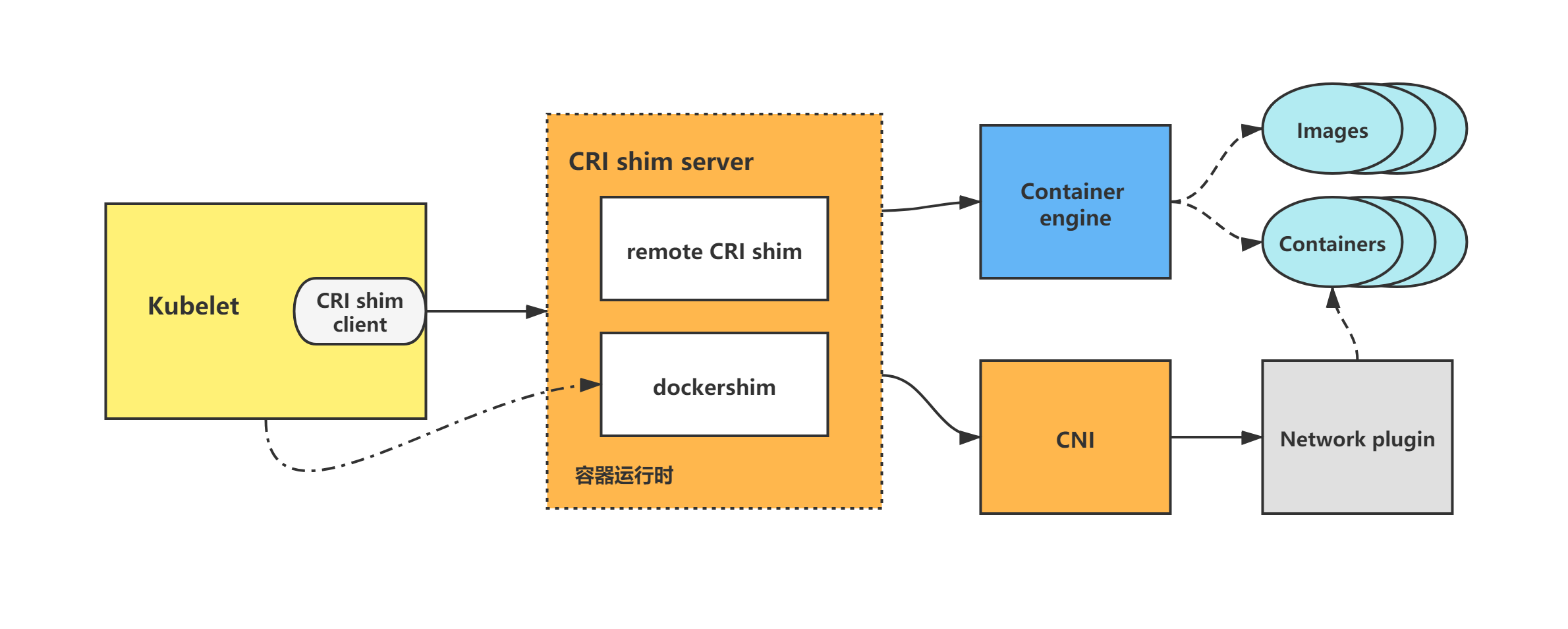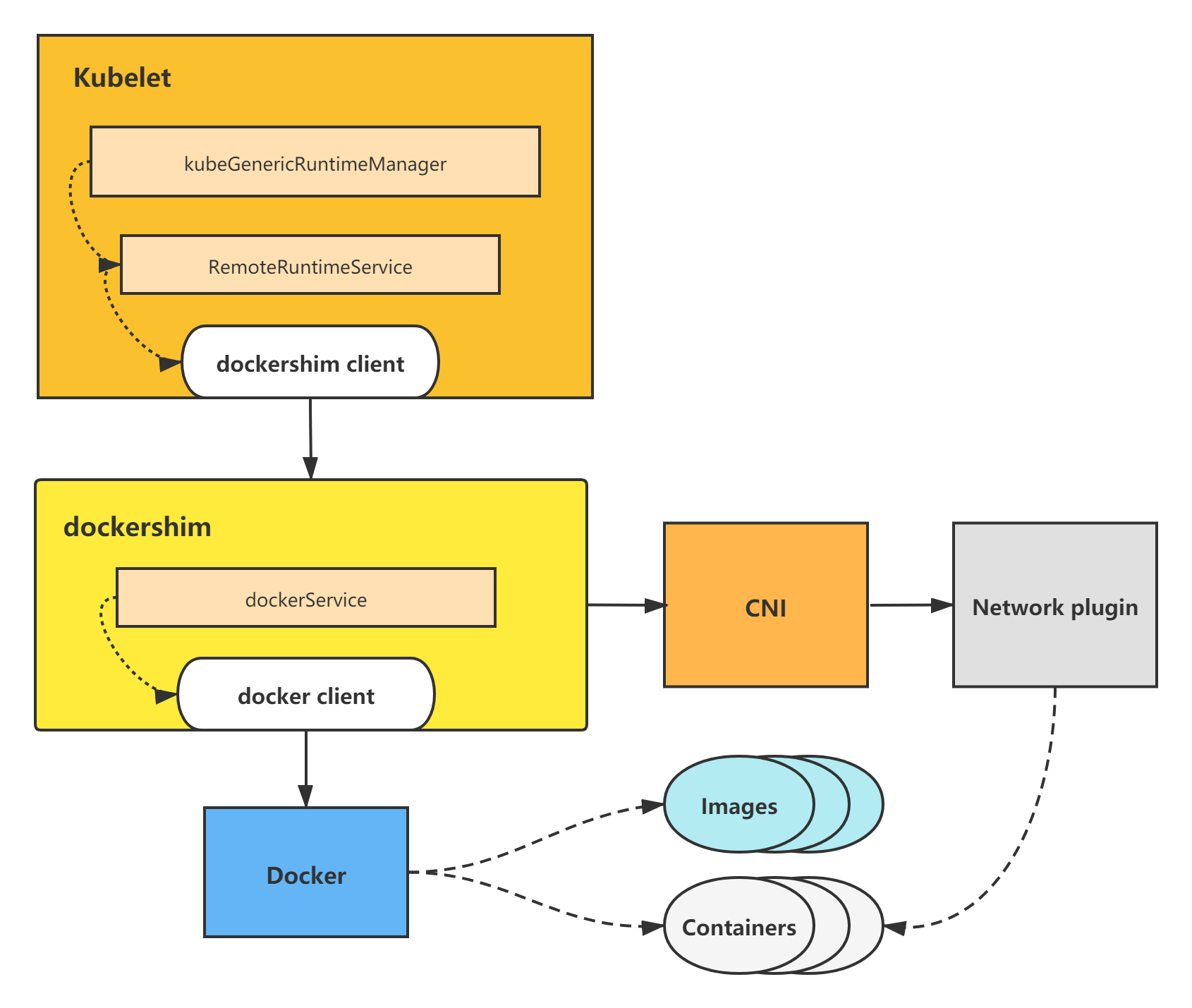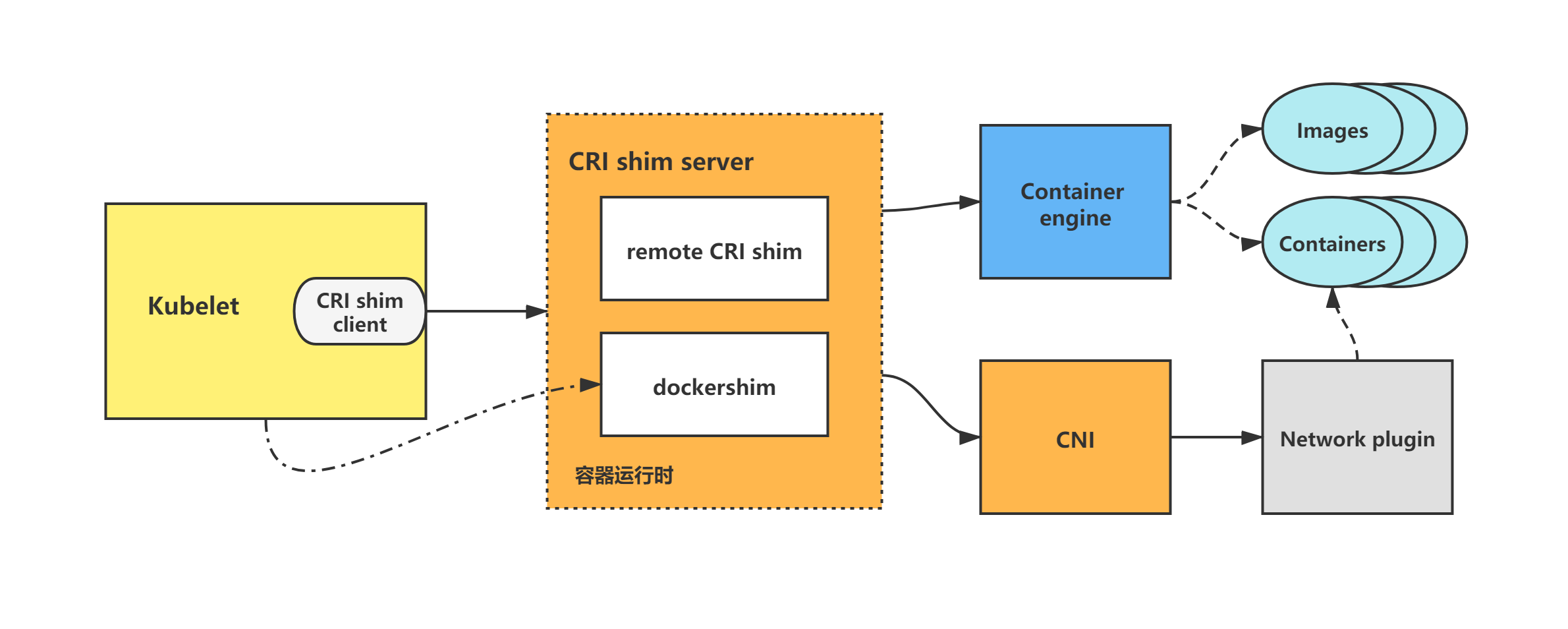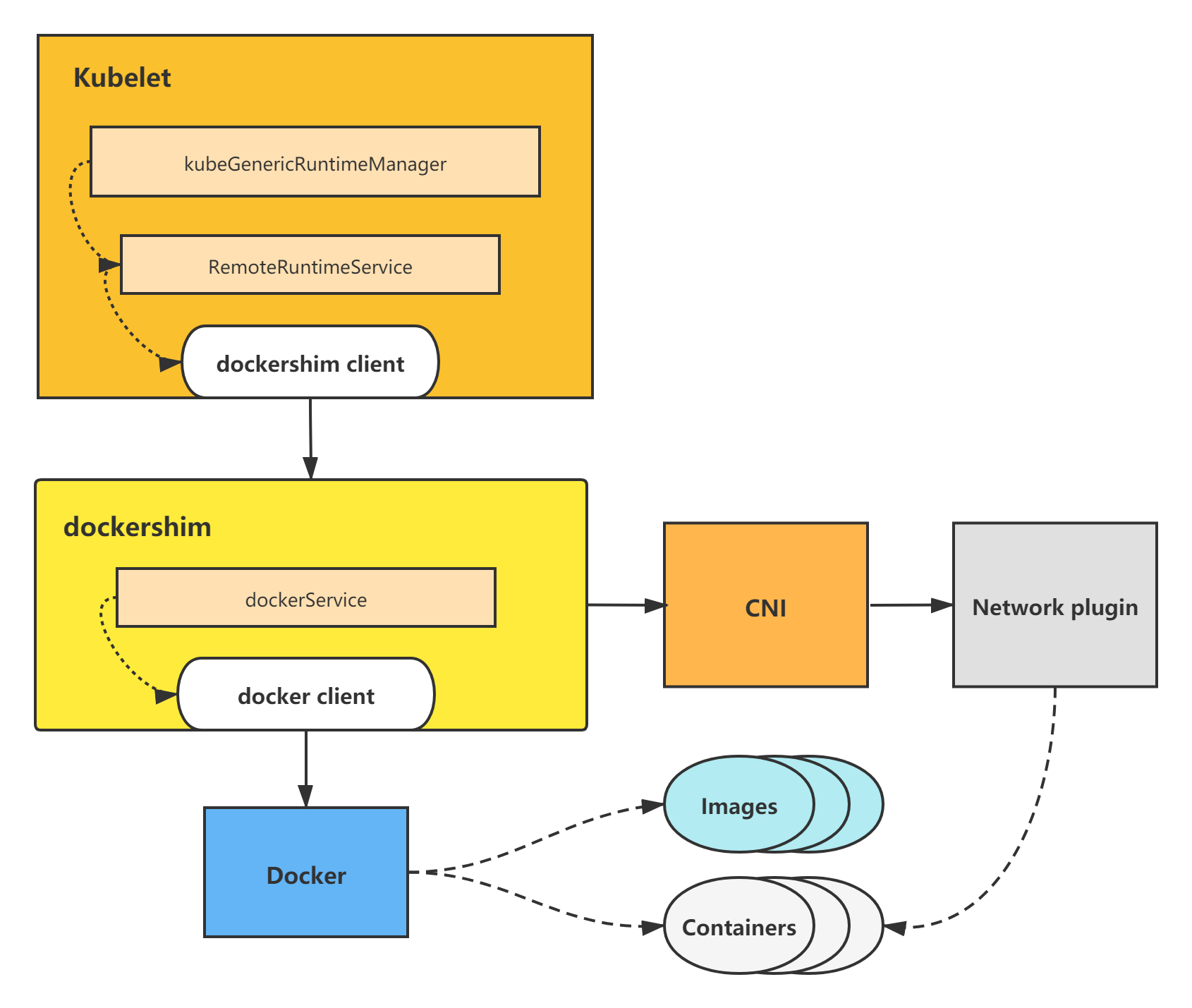kubernetes/k8s CRI分析-kubelet删除pod分析
关联博客《kubernetes/k8s CRI 分析-容器运行时接口分析》
《kubernetes/k8s CRI分析-kubelet创建pod分析》
之前的博文先对 CRI 做了介绍,然后对 kubelet CRI 相关源码包括 kubelet 组件 CRI 相关启动参数分析、CRI 相关 interface/struct 分析、CRI 相关初始化分析、kubelet调用CRI创建pod分析 4 个部分进行了分析,没有看的小伙伴,可以点击上面的链接去看一下。
把之前博客分析到的 CRI 架构图再贴出来一遍。

本篇博文将对 kubelet 调用 CRI 删除 pod 做分析。
kubelet中CRI相关的源码分析
kubelet的CRI源码分析包括如下几部分:
(1)kubelet CRI相关启动参数分析;
(2)kubelet CRI相关interface/struct分析;
(3)kubelet CRI初始化分析;
(4)kubelet调用CRI创建pod分析;
(5)kubelet调用CRI删除pod分析。
上两篇博文先对前四部分做了分析,本篇博文将对kubelet调用CRI删除pod做分析。
基于tag v1.17.4
https://github.com/kubernetes/kubernetes/releases/tag/v1.17.4
5.kubelet调用CRI删除pod分析
kubelet CRI删除pod调用流程
下面以kubelet dockershim删除pod调用流程为例做一下分析。
kubelet通过调用dockershim来停止容器,而dockershim则调用docker来停止容器,并调用CNI来删除pod网络。
图1:kubelet dockershim删除pod调用图示

dockershim属于kubelet内置CRI shim,其余remote CRI shim的创建pod调用流程其实与dockershim调用基本一致,只不过是调用了不同的容器引擎来操作容器,但一样由CRI shim调用CNI来删除pod网络。
下面进行详细的源码分析。
直接看到kubeGenericRuntimeManager的KillPod方法,调用CRI删除pod的逻辑将在该方法里触发发起。
从该方法代码也可以看出,kubelet删除一个pod的逻辑为:
(1)先停止属于该pod的所有containers;
(2)然后再停止pod sandbox容器。
注意点:这里只是停止容器,而删除容器的操作由kubelet的gc来做。
// pkg/kubelet/kuberuntime/kuberuntime_manager.go
// KillPod kills all the containers of a pod. Pod may be nil, running pod must not be.
// gracePeriodOverride if specified allows the caller to override the pod default grace period.
// only hard kill paths are allowed to specify a gracePeriodOverride in the kubelet in order to not corrupt user data.
// it is useful when doing SIGKILL for hard eviction scenarios, or max grace period during soft eviction scenarios.
func (m *kubeGenericRuntimeManager) KillPod(pod *v1.Pod, runningPod kubecontainer.Pod, gracePeriodOverride *int64) error {
err := m.killPodWithSyncResult(pod, runningPod, gracePeriodOverride)
return err.Error()
}
// killPodWithSyncResult kills a runningPod and returns SyncResult.
// Note: The pod passed in could be *nil* when kubelet restarted.
func (m *kubeGenericRuntimeManager) killPodWithSyncResult(pod *v1.Pod, runningPod kubecontainer.Pod, gracePeriodOverride *int64) (result kubecontainer.PodSyncResult) {
killContainerResults := m.killContainersWithSyncResult(pod, runningPod, gracePeriodOverride)
for _, containerResult := range killContainerResults {
result.AddSyncResult(containerResult)
}
// stop sandbox, the sandbox will be removed in GarbageCollect
killSandboxResult := kubecontainer.NewSyncResult(kubecontainer.KillPodSandbox, runningPod.ID)
result.AddSyncResult(killSandboxResult)
// Stop all sandboxes belongs to same pod
for _, podSandbox := range runningPod.Sandboxes {
if err := m.runtimeService.StopPodSandbox(podSandbox.ID.ID); err != nil {
killSandboxResult.Fail(kubecontainer.ErrKillPodSandbox, err.Error())
klog.Errorf("Failed to stop sandbox %q", podSandbox.ID)
}
}
return
}
5.1 m.killContainersWithSyncResult
m.killContainersWithSyncResult作用:停止属于该pod的所有containers。
主要逻辑:起与容器数量相同的goroutine,调用m.killContainer来停止容器。
// pkg/kubelet/kuberuntime/kuberuntime_container.go
// killContainersWithSyncResult kills all pod's containers with sync results.
func (m *kubeGenericRuntimeManager) killContainersWithSyncResult(pod *v1.Pod, runningPod kubecontainer.Pod, gracePeriodOverride *int64) (syncResults []*kubecontainer.SyncResult) {
containerResults := make(chan *kubecontainer.SyncResult, len(runningPod.Containers))
wg := sync.WaitGroup{}
wg.Add(len(runningPod.Containers))
for _, container := range runningPod.Containers {
go func(container *kubecontainer.Container) {
defer utilruntime.HandleCrash()
defer wg.Done()
killContainerResult := kubecontainer.NewSyncResult(kubecontainer.KillContainer, container.Name)
if err := m.killContainer(pod, container.ID, container.Name, "", gracePeriodOverride); err != nil {
killContainerResult.Fail(kubecontainer.ErrKillContainer, err.Error())
}
containerResults <- killContainerResult
}(container)
}
wg.Wait()
close(containerResults)
for containerResult := range containerResults {
syncResults = append(syncResults, containerResult)
}
return
}
5.1.1 m.killContainer
m.killContainer方法主要是调用m.runtimeService.StopContainer。
runtimeService即RemoteRuntimeService,实现了CRI shim客户端-容器运行时接口RuntimeService interface,持有与CRI shim容器运行时服务端通信的客户端。所以调用m.runtimeService.StopContainer,实际上等于调用了CRI shim服务端的StopContainer方法,来进行容器的停止操作。
// pkg/kubelet/kuberuntime/kuberuntime_container.go
// killContainer kills a container through the following steps:
// * Run the pre-stop lifecycle hooks (if applicable).
// * Stop the container.
func (m *kubeGenericRuntimeManager) killContainer(pod *v1.Pod, containerID kubecontainer.ContainerID, containerName string, message string, gracePeriodOverride *int64) error {
...
klog.V(2).Infof("Killing container %q with %d second grace period", containerID.String(), gracePeriod)
err := m.runtimeService.StopContainer(containerID.ID, gracePeriod)
if err != nil {
klog.Errorf("Container %q termination failed with gracePeriod %d: %v", containerID.String(), gracePeriod, err)
} else {
klog.V(3).Infof("Container %q exited normally", containerID.String())
}
m.containerRefManager.ClearRef(containerID)
return err
}
m.runtimeService.StopContainer
m.runtimeService.StopContainer方法,会调用r.runtimeClient.StopContainer,即利用CRI shim客户端,调用CRI shim服务端来进行停止容器的操作。
分析到这里,kubelet中的CRI相关调用就分析完毕了,接下来将会进入到CRI shim(以kubelet内置CRI shim-dockershim为例)里进行停止容器的操作分析。
// pkg/kubelet/remote/remote_runtime.go
// StopContainer stops a running container with a grace period (i.e., timeout).
func (r *RemoteRuntimeService) StopContainer(containerID string, timeout int64) error {
// Use timeout + default timeout (2 minutes) as timeout to leave extra time
// for SIGKILL container and request latency.
t := r.timeout + time.Duration(timeout)*time.Second
ctx, cancel := getContextWithTimeout(t)
defer cancel()
r.logReduction.ClearID(containerID)
_, err := r.runtimeClient.StopContainer(ctx, &runtimeapi.StopContainerRequest{
ContainerId: containerID,
Timeout: timeout,
})
if err != nil {
klog.Errorf("StopContainer %q from runtime service failed: %v", containerID, err)
return err
}
return nil
}
5.1.2 r.runtimeClient.StopContainer
接下来将会以dockershim为例,进入到CRI shim来进行停止容器操作的分析。
前面kubelet调用r.runtimeClient.StopContainer,会进入到dockershim下面的StopContainer方法。
// pkg/kubelet/dockershim/docker_container.go
// StopContainer stops a running container with a grace period (i.e., timeout).
func (ds *dockerService) StopContainer(_ context.Context, r *runtimeapi.StopContainerRequest) (*runtimeapi.StopContainerResponse, error) {
err := ds.client.StopContainer(r.ContainerId, time.Duration(r.Timeout)*time.Second)
if err != nil {
return nil, err
}
return &runtimeapi.StopContainerResponse{}, nil
}
ds.client.StopContainer
主要是调用d.client.ContainerStop。
// pkg/kubelet/dockershim/libdocker/kube_docker_client.go
// Stopping an already stopped container will not cause an error in dockerapi.
func (d *kubeDockerClient) StopContainer(id string, timeout time.Duration) error {
ctx, cancel := d.getCustomTimeoutContext(timeout)
defer cancel()
err := d.client.ContainerStop(ctx, id, &timeout)
if ctxErr := contextError(ctx); ctxErr != nil {
return ctxErr
}
return err
}
d.client.ContainerStop
构建请求参数,向docker指定的url发送http请求,停止容器。
// vendor/github.com/docker/docker/client/container_stop.go
// ContainerStop stops a container. In case the container fails to stop
// gracefully within a time frame specified by the timeout argument,
// it is forcefully terminated (killed).
//
// If the timeout is nil, the container's StopTimeout value is used, if set,
// otherwise the engine default. A negative timeout value can be specified,
// meaning no timeout, i.e. no forceful termination is performed.
func (cli *Client) ContainerStop(ctx context.Context, containerID string, timeout *time.Duration) error {
query := url.Values{}
if timeout != nil {
query.Set("t", timetypes.DurationToSecondsString(*timeout))
}
resp, err := cli.post(ctx, "/containers/"+containerID+"/stop", query, nil, nil)
ensureReaderClosed(resp)
return err
}
5.2 m.runtimeService.StopPodSandbox
在m.runtimeService.StopPodSandbox中的runtimeService即RemoteRuntimeService,其实现了CRI shim客户端-容器运行时接口RuntimeService interface,持有与CRI shim容器运行时服务端通信的客户端。所以调用m.runtimeService.StopPodSandbox,实际上等于调用了CRI shim服务端的StopPodSandbox方法,来进行pod sandbox的停止操作。
分析到这里,kubelet中的CRI相关调用就分析完毕了,接下来将会进入到CRI shim(以kubelet内置CRI shim-dockershim为例)里进行停止pod sandbox的分析。
// pkg/kubelet/remote/remote_runtime.go
// StopPodSandbox stops the sandbox. If there are any running containers in the
// sandbox, they should be forced to termination.
func (r *RemoteRuntimeService) StopPodSandbox(podSandBoxID string) error {
ctx, cancel := getContextWithTimeout(r.timeout)
defer cancel()
_, err := r.runtimeClient.StopPodSandbox(ctx, &runtimeapi.StopPodSandboxRequest{
PodSandboxId: podSandBoxID,
})
if err != nil {
klog.Errorf("StopPodSandbox %q from runtime service failed: %v", podSandBoxID, err)
return err
}
return nil
}
5.2.1 r.runtimeClient.StopPodSandbox
接下来将会以dockershim为例,进入到CRI shim来进行停止pod sandbox的分析。
前面kubelet调用r.runtimeClient.StopPodSandbox,会进入到dockershim下面的StopPodSandbox方法。
停止pod sandbox主要有2个步骤:
(1)调用ds.network.TearDownPod:删除pod网络;
(2)调用ds.client.StopContainer:停止pod sandbox容器。
需要注意的是,上面的2个步骤只有都成功了,停止pod sandbox的操作才算成功,且上面2个步骤成功的先后顺序没有要求。
// pkg/kubelet/dockershim/docker_sandbox.go
// StopPodSandbox stops the sandbox. If there are any running containers in the
// sandbox, they should be force terminated.
// TODO: This function blocks sandbox teardown on networking teardown. Is it
// better to cut our losses assuming an out of band GC routine will cleanup
// after us?
func (ds *dockerService) StopPodSandbox(ctx context.Context, r *runtimeapi.StopPodSandboxRequest) (*runtimeapi.StopPodSandboxResponse, error) {
var namespace, name string
var hostNetwork bool
podSandboxID := r.PodSandboxId
resp := &runtimeapi.StopPodSandboxResponse{}
// Try to retrieve minimal sandbox information from docker daemon or sandbox checkpoint.
inspectResult, metadata, statusErr := ds.getPodSandboxDetails(podSandboxID)
if statusErr == nil {
namespace = metadata.Namespace
name = metadata.Name
hostNetwork = (networkNamespaceMode(inspectResult) == runtimeapi.NamespaceMode_NODE)
} else {
checkpoint := NewPodSandboxCheckpoint("", "", &CheckpointData{})
checkpointErr := ds.checkpointManager.GetCheckpoint(podSandboxID, checkpoint)
// Proceed if both sandbox container and checkpoint could not be found. This means that following
// actions will only have sandbox ID and not have pod namespace and name information.
// Return error if encounter any unexpected error.
if checkpointErr != nil {
if checkpointErr != errors.ErrCheckpointNotFound {
err := ds.checkpointManager.RemoveCheckpoint(podSandboxID)
if err != nil {
klog.Errorf("Failed to delete corrupt checkpoint for sandbox %q: %v", podSandboxID, err)
}
}
if libdocker.IsContainerNotFoundError(statusErr) {
klog.Warningf("Both sandbox container and checkpoint for id %q could not be found. "+
"Proceed without further sandbox information.", podSandboxID)
} else {
return nil, utilerrors.NewAggregate([]error{
fmt.Errorf("failed to get checkpoint for sandbox %q: %v", podSandboxID, checkpointErr),
fmt.Errorf("failed to get sandbox status: %v", statusErr)})
}
} else {
_, name, namespace, _, hostNetwork = checkpoint.GetData()
}
}
// WARNING: The following operations made the following assumption:
// 1. kubelet will retry on any error returned by StopPodSandbox.
// 2. tearing down network and stopping sandbox container can succeed in any sequence.
// This depends on the implementation detail of network plugin and proper error handling.
// For kubenet, if tearing down network failed and sandbox container is stopped, kubelet
// will retry. On retry, kubenet will not be able to retrieve network namespace of the sandbox
// since it is stopped. With empty network namespcae, CNI bridge plugin will conduct best
// effort clean up and will not return error.
errList := []error{}
ready, ok := ds.getNetworkReady(podSandboxID)
if !hostNetwork && (ready || !ok) {
// Only tear down the pod network if we haven't done so already
cID := kubecontainer.BuildContainerID(runtimeName, podSandboxID)
err := ds.network.TearDownPod(namespace, name, cID)
if err == nil {
ds.setNetworkReady(podSandboxID, false)
} else {
errList = append(errList, err)
}
}
if err := ds.client.StopContainer(podSandboxID, defaultSandboxGracePeriod); err != nil {
// Do not return error if the container does not exist
if !libdocker.IsContainerNotFoundError(err) {
klog.Errorf("Failed to stop sandbox %q: %v", podSandboxID, err)
errList = append(errList, err)
} else {
// remove the checkpoint for any sandbox that is not found in the runtime
ds.checkpointManager.RemoveCheckpoint(podSandboxID)
}
}
if len(errList) == 0 {
return resp, nil
}
// TODO: Stop all running containers in the sandbox.
return nil, utilerrors.NewAggregate(errList)
}
ds.client.StopContainer
主要是调用d.client.ContainerStop。
// pkg/kubelet/dockershim/libdocker/kube_docker_client.go
// Stopping an already stopped container will not cause an error in dockerapi.
func (d *kubeDockerClient) StopContainer(id string, timeout time.Duration) error {
ctx, cancel := d.getCustomTimeoutContext(timeout)
defer cancel()
err := d.client.ContainerStop(ctx, id, &timeout)
if ctxErr := contextError(ctx); ctxErr != nil {
return ctxErr
}
return err
}
d.client.ContainerStop
构建请求参数,向docker指定的url发送http请求,停止pod sandbox容器。
// vendor/github.com/docker/docker/client/container_stop.go
// ContainerStop stops a container. In case the container fails to stop
// gracefully within a time frame specified by the timeout argument,
// it is forcefully terminated (killed).
//
// If the timeout is nil, the container's StopTimeout value is used, if set,
// otherwise the engine default. A negative timeout value can be specified,
// meaning no timeout, i.e. no forceful termination is performed.
func (cli *Client) ContainerStop(ctx context.Context, containerID string, timeout *time.Duration) error {
query := url.Values{}
if timeout != nil {
query.Set("t", timetypes.DurationToSecondsString(*timeout))
}
resp, err := cli.post(ctx, "/containers/"+containerID+"/stop", query, nil, nil)
ensureReaderClosed(resp)
return err
}
总结
CRI架构图
在 CRI 之下,包括两种类型的容器运行时的实现:
(1)kubelet内置的 dockershim,实现了 Docker 容器引擎的支持以及 CNI 网络插件(包括 kubenet)的支持。dockershim代码内置于kubelet,被kubelet调用,让dockershim起独立的server来建立CRI shim,向kubelet暴露grpc server;
(2)外部的容器运行时,用来支持 rkt、containerd 等容器引擎的外部容器运行时。

kubelet调用CRI删除pod流程分析
kubelet删除一个pod的逻辑为:
(1)先停止属于该pod的所有containers;
(2)然后再停止pod sandbox容器(包括删除pod网络)。
注意点:这里只是停止容器,而删除容器的操作由kubelet的gc来做。
kubelet CRI删除pod调用流程
下面以kubelet dockershim删除pod调用流程为例做一下分析。
kubelet通过调用dockershim来停止容器,而dockershim则调用docker来停止容器,并调用CNI来删除pod网络。
图1:kubelet dockershim删除pod调用图示

dockershim属于kubelet内置CRI shim,其余remote CRI shim的创建pod调用流程其实与dockershim调用基本一致,只不过是调用了不同的容器引擎来操作容器,但一样由CRI shim调用CNI来删除pod网络。
关联博客《kubernetes/k8s CRI 分析-容器运行时接口分析》
《kubernetes/k8s CRI分析-kubelet创建pod分析》
kubernetes/k8s CRI分析-kubelet删除pod分析的更多相关文章
- kubernetes/k8s CRI分析-kubelet创建pod分析
先来简单回顾上一篇博客<kubernetes/k8s CRI 分析-容器运行时接口分析>的内容. 上篇博文先对 CRI 做了介绍,然后对 kubelet CRI 相关源码包括 kubele ...
- kubernetes/k8s CRI分析-容器运行时接口分析
关联博客:kubernetes/k8s CSI分析-容器存储接口分析 概述 kubernetes的设计初衷是支持可插拔架构,从而利于扩展kubernetes的功能.在此架构思想下,kubernetes ...
- Kubernetes K8S之通过yaml文件创建Pod与Pod常用字段详解
YAML语法规范:在kubernetes k8s中如何通过yaml文件创建pod,以及pod常用字段详解 YAML 语法规范 K8S 里所有的资源或者配置都可以用 yaml 或 Json 定义.YAM ...
- kubelet源码分析——关闭Pod
上一篇说到kublet如何启动一个pod,本篇讲述如何关闭一个Pod,引用一段来自官方文档介绍pod的生命周期的话 你使用 kubectl 工具手动删除某个特定的 Pod,而该 Pod 的体面终止限期 ...
- kubelet源码分析——启动Pod
前文说到Kubelet启动时,调用到kubelet.Run方法,里面最核心的就是调用到kubelet.syncLoop.它是一个循环,这个循环里面有若干个检查和同步操作,其中一个是地在监听Pod的增删 ...
- kubernetes/k8s CNI分析-容器网络接口分析
关联博客:kubernetes/k8s CSI分析-容器存储接口分析 kubernetes/k8s CRI分析-容器运行时接口分析 概述 kubernetes的设计初衷是支持可插拔架构,从而利于扩展k ...
- Kubernetes K8S之资源控制器Daemonset详解
Kubernetes的资源控制器Daemonset详解与示例 主机配置规划 服务器名称(hostname) 系统版本 配置 内网IP 外网IP(模拟) k8s-master CentOS7.7 2C/ ...
- Kubernetes K8S之存储ConfigMap详解
K8S之存储ConfigMap概述与说明,并详解常用ConfigMap示例 主机配置规划 服务器名称(hostname) 系统版本 配置 内网IP 外网IP(模拟) k8s-master CentOS ...
- 12.深入k8s:kubelet创建pod流程源码分析
转载请声明出处哦~,本篇文章发布于luozhiyun的博客:https://www.luozhiyun.com 源码版本是1.19 在上一篇中,我们知道在kubelet中,工作核心就是围绕着整个syn ...
随机推荐
- 『无为则无心』Python序列 — 22、Python集合及其常用操作
目录 1.Python集合特点 2.Python集合的创建 3.操作集合常用API (1)增加数据 @1.add()方法 @2.update()方法 (2)删除数据 @1.remove()方法 @2. ...
- 友华新光猫PT924G破解telnet之路
最近去找电信要了个新的千兆光猫(电信宽带300兆配100兆光猫真鸡贼),背后一看不是华为了,是友华PT924G,在http://192.168.1.1:8080/里看到了熟悉的电信界面 用teleco ...
- 1.3.8、通过RemoteAddr匹配
server: port: 8080 spring: application: name: gateway cloud: gateway: routes: - id: guo-system4 uri: ...
- mysql json_extract函数获取json字段中某个key的值
参考:https://www.cnblogs.com/chuanzhang053/p/9139624.html json_extract函数可以获取json对象中指定key的值,用法:json_ext ...
- python链接postgresql
#需要安装的库 sudo apt-get install build-dep python-psycopg2 pip install psycopg2 #!/usr/bin/python # -*- ...
- .NET Core/.NET5/.NET6 开源项目汇总11:WPF组件库1
系列目录 [已更新最新开发文章,点击查看详细] WPF(Windows Presentation Foundation)是微软推出的基于Windows 的用户界面框架,属于.NET Frame ...
- Linux之19——Shell编程基础详解
第一部分:Linux Shell 简介 Shell 是一个用 C 语言编写的程序,它是用户使用 Linux 的桥梁.Shell 既是一种命令语言,又是一种程序设计语言. Shell 是指一种应用程序, ...
- C语言:强制类型转换
#include <stdio.h> //强制类型转换 //写法:(类型标识符)变量:(类型标识符)常量:(类型标识符)(表达式):三种格式 main() { float a=7.5f; ...
- 一行代码打印python之禅
就这一句: import this 输出: The Zen of Python, by Tim Peters Beautiful is better than ugly. Explicit is be ...
- airodump-ng的使用及显示
PWR 表示所接收的信号的强度.表示为负数,数值赿大表示信号赿强.(绝对值赿大,数据赿值小) beacons 表示网卡接收到的AP发出的信号个数
